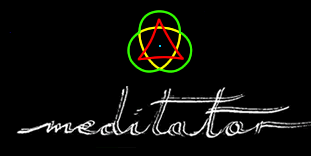FROM MEDITATOR.ORG
'Posture'
As one
meditates one soon becomes aware of a continuous interplay
between the outer posture of the body and the inner posture of
the
meditator within.
The inner
posture is like an attitude that one holds onto whilst
meditating and it is produced by the type of effort that one uses
to
meditate.
So for example if one’s inner posture is too rigid , maybe trying
too
hard to grasp at the object of meditation then the object
of
meditation seems to ‘run away’ from the meditator. The inner
attitude
here is too forceful and the body’s muscles might tighten as a
result
of such mental strain.
Also if one's inner attitude is too lax, unenthusiastic or
inattentive of the meditation then one is easily overcome by
one's own thoughts, memories or fantasies.
Both of these above extremes often deplete one's energetic
resources
and as a result the necessary attention needed to be able to
meditate
wanes and sleep eventually takes over.
Even though it
may seem almost impossible at first, with patience and
the right effort one finds eventually some meditation sessions
when
the inner posture is 'just right', when suddenly all of the
body's
energies appear to rise up and suddenly it is as if the
keen
meditator and his object of meditation are 'in their proper
and
natural places'.
This is a sign
that a dynamic balance has been reached where the
practitioner’s body / mind, his inner efforts and the object
of
meditation are all working together harmoniously. If this
new
condition is maintained then one can extend awareness
almost
indefinitely.
‘Good’ meditation sessions are probably not chance incidents but
the
result of long term effort meditating earnestly. They depend on
what
has gone on before in previous
sessions.
Our inner
attitude whilst meditating is also directly linked to the
many preconceived ideas that we hold about our bodies and minds.
If
we are easily moved by feelings of disgust or self
congratulation
then our meditation will suffer. Beliefs are for the most
part
conditioned by our cultural and family background. They were
probablyonce accepted unquestionably but are often
erroneous and outdated tobe useful now and so should be
re-examined in the light of our own present
experiences.
In some forms of meditation the 'inner posture' is
worked upon by
the body adopting either static physical postures or
executing
particular movements or dances. In this way the mind-body complex
can reach formless worlds.
It has been
said that the 'body is the mirror of the mind'.
Ultimately we are neither our body nor our mind yet we must know
how to use both efficiently in order to meditate over a
sustained period
of time.
At the end of our meditation sessions, using perhaps the calm
state
of mind that meditation often produces, it is worth asking
oneself
frequently the time honoured question:
"who or what am I really?".
This type of inner question can foster courage and the
forbearance to
perceive oneself as one really is and so as a result of this
practice
one’s inner attitude when one meditates may probably become more
open too.
The good news
is that with regular meditation practice one learns how
one learns.
As if we were a juggler we can play with some of the elements
that
make up who we are and this is a joyful activity.
While we are alive we can work to enhance awareness and that is
a
step towards real freedom
-Copyright Byron
Zeliotis-
|
